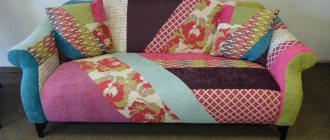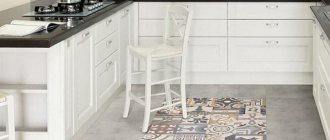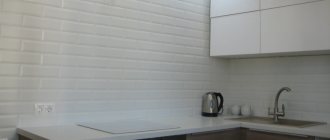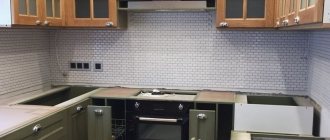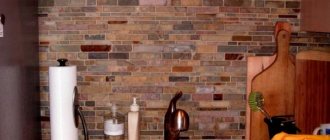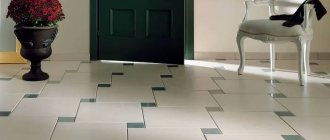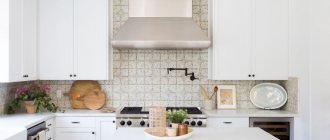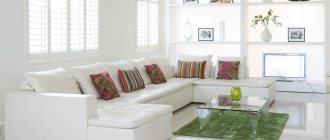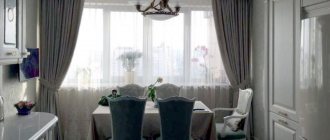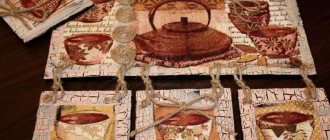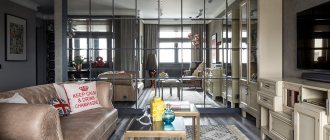From time immemorial, practical housewives and needlewomen have used patchwork techniques to make blankets, bedspreads, and capes from the remains of various materials. Now the trend with the foreign name “patchwork” has again become incredibly popular.
Moreover, the scope of its application has expanded significantly. Modern technologies have made it possible to use this decor in the production of ceramic tiles. The world's leading brands produce finishing materials that can transform the environment, give it charm and originality. The patchwork style looks especially good in the kitchen interior.
Features of a patchwork kitchen
Using patchwork you can create an accent
It is impossible to overestimate the role of the kitchen. The attractiveness and functionality of its interior are undoubtedly important. But not only these factors need to be taken into account when decorating the interior. The mood of the hostess, the taste and quality of the dishes, and the atmosphere of family relationships depend on the degree of coziness and comfort in this room. Patchwork style in the kitchen will help create the required conditions, turn it into an oasis of warmth, a source of good mood. Cheerful, bright “rugs” on the walls:
- the warmth of the family hearth is emphasized;
- will relieve boredom and help take your mind off sad thoughts;
- will create a desire to create culinary masterpieces;
- will provide a pleasant atmosphere during family meals and friendly meetings.
Wall decoration, panels or patchwork aprons in the kitchen are an expressive, interesting accent. Such elements guarantee originality to the interior, which is fully consistent with today's fashion trends.
The brighter the tiles in the patchwork style, the other elements of the interior are decorated in soothing colors
Photos of kitchens in the patchwork style demonstrate the ability of this decor to successfully complement a variety of styles. You can use it in classic and modern directions.
Styling tips
Before installing the apron, markings are made. Using chalk, silhouettes of furniture modules are applied to the walls so that each of them takes its place. After this, lines of the edges of the cladding are drawn on the wall. A metal profile or wooden beam is attached to the lower border.
The tile adhesive is applied in a thick layer and then leveled using a notched trowel. After placing each row of tiles, check the clarity of the line using a building level. After finishing the cladding, inspect the surface of the apron for the presence of glue. If contamination is detected, the stained areas of the ceramic are immediately cleaned.
Options for using patchwork in the kitchen interior
Patchwork tiles for the kitchen are offered in different versions. The charm of this finishing material is beyond doubt. But it is necessary to use it in the interior in limited quantities. The abundance of variegation inherent in patchwork can spoil the impression.
Like a rug, patchwork tiles are the centerpiece of the decor.
Patchwork tiles in the kitchen are used to create an accent. This capacity may include:
- apron;
- one wall;
- horizontal panel on the walls;
- floor;
- insert or panel;
- textile.
an apron in a patchwork style in bright colors will please the eye
The most popular use of this material is to decorate the space between wall cabinets and the lower tier of furniture. Using patchwork tiles in a kitchen backsplash can be considered the best option. In terms of strength and resistance to negative influences, this material fully meets the requirements. A colorful, playful patchwork apron in the kitchen will provide the hostess with a boost of vivacity and good mood.
One kitchen wall with patchwork tiles can become a successful design accent. This technique is ideal if the interior of the room turns out to be too laconic and faceless. In addition, with the right selection of shades, this design will help visually adjust the room. You can use designer photos of kitchens in patchwork style as a guide.
patchwork style cushion on kitchen chairs as an element of kitchen decor
A fashionable design trend now is a combined finish that divides the walls into two parts horizontally. Patchwork tiles in the kitchen will not only create an original wall design, but will also simplify the cleaning process. The lower part of the walls, lined with such material, will be easy to clean from dirt, which is difficult to avoid in this room.
A patchwork tile floor looks perfect in a kitchen interior. It successfully imitates a cozy rug and makes the room feel comfortable. Durable material will not lose its properties from regular washing or exposure to household chemicals, and will retain its pristine beauty for many years.
Patchwork kitchen tiles in black and white tones are ideal for kitchens decorated in a modern style
It is not always advisable to use this style for large-scale elements. The accent may take up a small space. You can create a patchwork panel from tiles in the kitchen, and use this decor as an effective insert in a plain finish. Since it provides an atmosphere of warmth and comfort, it is appropriate to use such decoration in the dining area. It does not require high strength or stability of materials. You can make a patchwork panel for the kitchen with your own hands from textiles and other available materials.
An apron in a patchwork style attracts attention the first time
Textiles in this design look impressive and interesting. Such products can be found in a modern assortment. Craftswomen will be able to make patchwork-style items for the kitchen with their own hands.
Patchwork on the floor
In terms of flooring, patchwork is often laid out in a room so that it looks like a functional area rug, but made of tiles. You can place it under the dining table or around the island.
This year there were also many innovations inspired by complex shapes, in particular the following became popular:
- hexagonal;
- glass mosaic;
- trend for walls and floors: thin-walled tiles;
- extended format;
- special tiles for the patio area.
Floor decoration
Popular patterns include bright, expressive works that imitate manual labor in the Old World style and hand-painted cement tiles. Using today's inkjet and digital printing technology, the look and texture of the latter is more realistic than ever before.
Variety of patchwork
A significant attractive factor of patchwork tiles for the kitchen is the variety of types, themes, and shades. There are no restrictions in creating decor for these materials, which provides designers with complete freedom of creativity. In the decoration of walls, floors, patchwork aprons for the kitchen you can see drawings in the following themes:
- vegetable,
- floral,
- ethnic,
- geometric,
- animalistic,
- fantasy, etc.
Decorating the floor and backsplash with ceramic tiles in patchwork style
You can choose the material based on the canons of style, personal interests, and preferences.
Patchwork tiles for the kitchen differ not only in the theme of the prints. In the category of this finishing there are colored materials, made in several tones of the same range. This provides the opportunity to implement various creative patchwork ideas for the kitchen.
Floor mosaic
Patchwork mosaic for the floor must be wear-resistant, designed for heavy loads, and resistant to chemical detergents. The color range of products is standard and must correspond to the uniform style of decoration of the room.
For long-term operation, it is important to consider the thickness and dimensions. Floor elements are available in large sizes for easy installation.
It is necessary to take into account the low thermal conductivity of coatings and install a “warm floor” system.
When selecting materials for floor finishing, experts advise choosing durable porcelain stoneware blocks. The products are evenly tinted and more durable under constant mechanical stress.
In ceramic products, paint is applied to the surface; the slab is not painted in bulk and loses color intensity over time. Porcelain stoneware blocks are distinguished by their heavy weight and resistance to damage under loads.
You can tile the entire floor surface in the bathroom or create a long strip at the edge. The creation of accent inserts at the sink or shower with imitation carpet looks original.
Combining patchwork accents
When decorating a kitchen in a patchwork style, you need to take into account the features of this decor. You should not only limit its use and avoid excessive variegation, but also wisely combine this finish with other interior elements.
A bright and colorful patchwork sofa will become the main accent in a white kitchen
There are several recommendations from professional designers for using the patchwork style in the kitchen interior:
- patchwork is not used simultaneously in wall and floor decoration, textiles;
- the colors used in the decorative patterns must be combined with the main tones of the interior;
- bright designs use calm monochrome options;
- Patchwork style accents look good on a plain background;
- There is no need to use a lot of decorative elements in the interior if there is decor in this style.
Compliance with these rules will help you design a harmonious kitchen interior in a patchwork style and eliminate unnecessary variegation, which is a sign of bad taste.
Possible combinations
As you already understand, giving patchwork a dominant place in a kitchen renovation is a mistake. But in this case, you need to take a responsible approach to the choice of materials that shade it.
Turning to the history of the appearance of technology, it becomes clear that this is a rural invention. So it would be logical to use natural materials (or their high-quality imitation) - stone, wood, ceramics.
Try to avoid overly modern surfaces - plastic and glass can look good together with patchwork, but then there is no need to talk about respecting its stylistic features.
Make sure that the intended design project in the interior will look as great as in the photo - some people underestimate the brightness of such decorative elements against the backdrop of more restrained coatings.
Types of decoration, patchwork style decorations
Tablecloth for table in patchwork style
Now the most popular option is patchwork tiles in the kitchen. The widespread use of this material is due to its ideal functional characteristics that correspond to the specifics of the kitchen. Ceramic cladding can withstand difficult indoor conditions and has a long service life. You can decorate a kitchen apron with patchwork tiles, make the work area attractive, without spending a lot of time and effort to maintain cleanliness.
Hot stand in patchwork style
It is not necessary to limit yourself to these materials in interior design. High popularity contributes to the expansion of the range of decor. The simplicity of the technique makes it possible to create various patchwork-style items in the kitchen with your own hands. In creating the interior the following can be used:
- wallpaper;
- curtains;
- napkins and potholders;
- covers;
- rugs, etc.
Decorative elements in patchwork style
In the products of leading manufacturers for kitchens in a patchwork style, you can choose vinyl wallpaper that imitates patchwork technology. This material can be used in kitchen decoration. It has high strength, stability, and is suitable for wet cleaning. There are fabrics with such decor that can be used in sewing curtains and other items. On the Internet, needlewomen can find patterns for patchwork pot holders for the kitchen, curtains, covers for stools, etc.
Wall tiles
Elements using the patchwork technique are used to decorate wall panels. The slabs are lightweight for easy installation. The products are not designed for heavy loads, are decorative, and are available in different textures.
Wall elements are placed to accentuate the shower area, at the sink, or as a horizontal strip above the bathtub.
Surfaces must be resistant to humidity, frequent cleaning, and chemicals.
Apron in patchwork style
A patchwork apron for the kitchen is the most popular option. This element becomes a noticeable, expressive accent, gives the work area a cheerful note, and enlivens the interior. Sometimes after large-scale renovations, tiles of different shades, with patterns and plain ones remain. Since the style does not limit the choice of elements, these materials can become components of one composition. However, it is usually not possible to create a beautiful, high-quality patchwork apron in the kitchen in this way.
The patchwork of the apron should clearly match the contours of the surrounding furniture
Many manufacturers offer special design kits. A patchwork apron for the kitchen can be made from:
- ceramic tiles;
- mosaics;
- plastic.
If you purchase standard tiles of different shades to create an accent, you need to choose materials of the same brand. The optimal size of the elements is 10x10. The advantage of this method is the ability to accurately select shades taking into account the features of the interior, and create a unique pattern or ornament.
A bright apron breaks up the monotonous white kitchen interior
A beautiful patchwork apron in the kitchen is made from mosaic. This material is produced from various raw materials. There are glass, metal and ceramic mosaics. Smalt tiles are ideal for kitchens. If the sun's rays fall on it, a glow is formed, giving it a special charm.
Modern technologies make it possible to create plastic that has increased strength and resistance to various influences. Special patchwork tiles for kitchen backsplashes are available in a wide range. For any style you can find the best option.
Laying tiles is not difficult for homely owners. You can create a patchwork apron for the kitchen with your own hands, without involving professional specialists.
Weaving from wallpaper?
In fact, you don't need to do this. But you will have to think about which pieces to choose to create a patchwork mosaic.
As we have already said, one of the main features of the technique is rich and bright colors. For those who decide to buy a ready-made canvas, you just need to choose the one you like.
If you plan to choose a wallpaper design yourself in order to make a truly unique coating, you will need to work hard. However, modern technologies will solve the problem for you - there are programs that will find beautiful color combinations.
As for general recommendations, they are extremely simple:
- Select only one wall with patchwork, otherwise the kitchen will be too colorful.
- Choose wallpaper of different colors and textures, but of the same thickness.
- The remaining walls and decor should be as monochromatic as possible to highlight the beauty of the complex coating.
Manufacturing of textile decor
Curtains in the kitchen stylized as patchwork
Textile decor in patchwork style looks great in the kitchen interior. It provides maximum comfort, coziness, and adds cheerfulness to the atmosphere. For housewives with sewing skills, it will not be difficult to make original products. You can find on the websites patterns for patchwork potholders for the kitchen, curtains, covers for sofas and chairs, and stools. Many needlewomen will develop decor styles themselves.
Making patchwork items for the kitchen with your own hands allows you to:
- create unique things, give the interior individuality;
- accurately select shades, theme of elements, ensure impeccable harmony;
- find functional uses for unnecessary things.
patchwork style potholders
The absence of restrictions in the choice of materials allows you to use creative imagination and use various scraps that every housewife has. If it’s difficult to come up with options on your own, you can find numerous patchwork ideas for the kitchen on the Internet and choose the best options for your interior.
Unique patchwork panel in the kitchen
A patchwork panel for the kitchen can be an ideal decoration. This type of needlework is sure to captivate creative people who want to realize their ideas. Anyone can make a unique patchwork panel for the kitchen with their own hands, without spending significant money on this decor.
You can make these decorative elements yourself
It is not necessary to use traditional techniques for this. The most interesting option for such decor is quilting. Unlike the classical method, in which the canvas is made up of squares and rhombuses with different designs, a quilt allows you to create full-fledged paintings from scraps. The following may appear on a patchwork panel in the kitchen:
- everyday stories;
- flower arrangements;
- fruit still lifes;
- ethnic ornaments, etc.
A small panel in the kitchen in patchwork style
Fabric scraps are used in production, which every housewife can find. Subject matter and implementation depend on your own preferences and capabilities. There are interesting patchwork ideas for the kitchen on the Internet.
Advantages and disadvantages
Bright and catchy patchwork is quite difficult to combine with other styles, remaining within the boundaries of good taste.
Oversaturation of the interior with small colorful details will destroy a harmonious picture, create a jumble of colors and shapes, and quickly become boring and annoying. Important! Decorating a kitchen in a patchwork style can be done by people with excellent taste. An ill-considered mishmash of colors and patterns will turn the interior into cheap kitsch. If we talk about the traditional use of patchwork, then one of its advantages is the ability to use all the remnants of fabric, both new and used
For example, you can sew curtains for the kitchen in a patchwork style with your own hands literally “from what was there.” A combination of flaps of different color, texture, thickness and even shape is allowed, for example, a combination of squares, rectangles, rhombuses, triangles
If we talk about the traditional use of patchwork, then one of its advantages is the ability to use all leftover fabric, both new and used. For example, you can sew curtains for the kitchen in a patchwork style with your own hands literally “from what was there.” A combination of flaps of different color, texture, thickness and even shape is allowed, for example, a combination of squares, rectangles, rhombuses, triangles.
Advice! It is not necessary to buy patchwork curtain fabric for the kitchen. It’s enough to reconsider your wardrobe and pantry. You can go to your friends and acquaintances “with an outstretched hand,” in case they have unnecessary scraps lying around. As a last resort, you can go to a clothing factory; they always have scraps for sale.
A novelty in interior design is tiles for the floor and apron above the kitchen work surface. It will no longer be possible to select it according to the principle “from what was.” Sets of tiles designed for the kitchen, bathroom, and dining room, with all their diversity, are united by size, color or texture. That is, collecting assorted tiles left over from past times and creating a harmonious composition from them will not work.
It would be wrong to call patchwork the main style for kitchen interior design. These are additional accents that create the mood, highlight the rest of the design, and divide the room into zones. This cannot be said to be a flaw of the style, but rather a feature of it.
Rustic Patchwork
Kitchens in the patchwork style have incredible comfort and create an atmosphere of home. This decor is great for all rustic ethnic styles. A kitchen with patchwork tiles can be designed in the following styles:
- country,
- rustic,
- Provence,
- Scandinavian,
- eco.
Patchwork in kitchens decorated in a rustic style adds home comfort
A patchwork apron or panel will look harmonious in any of these directions. You can use patchwork tiles for the kitchen in wall decoration or panel cladding. A floor with such decor will look harmonious. In order to create a harmonious interior, observing the basic canons of style, you can look at photos of kitchens in the patchwork style.
Patchwork in the classics
There is no need to limit the scope of application of this material. You can use patchwork tiles in the interior of a kitchen decorated in a classic style. High-quality furniture made of wood or skillful imitation, finishing in calm, noble colors provide the room with sophistication and presentability. But it may lack the warmth that a kitchen needs.
Patchwork style finishing of columns
Patchwork tiles for the kitchen, which can be used to decorate an apron, floor or wall, will help correct this drawback. When choosing a material, you need to take into account the features of the classics and purchase options:
- monochrome in muted tones;
- in a shade corresponding to the main color scheme of the interior;
- with elegant designs.
In classic kitchens, patchwork does not disturb the harmony
Such decor will perfectly complement and enliven the design, without disturbing the harmony and sophistication.
A kitchen with patchwork tiles can be decorated in an Empire style. This decoration was widely used in Ancient Rome, providing an excellent background to the majestic columns and stucco decoration. Nowadays this accent is used to add a touch of comfort and warmth.
Internationality
Initially we said that the style originated in England. However, now it has become widespread - such a technique is often found in Japanese or French styles or a completely unexpected Art Deco patchwork.
The latter is distinguished by a more sophisticated range using pastel and golden shades.
Therefore, no matter what repair you decide to do, you will most likely find suitable patchwork accessories.
Patchwork in modern designs
In modern kitchens, bright ceramic tiles are used to decorate the apron, which will become the main accent in the interior.
Patchwork tiles will find their place in a modern-style kitchen. Trendy trends, such as minimalism, hi-tech, loft, have a lot of advantages and are fully consistent with the modern rhythm of life. But their laconicism is not always well suited for a room that needs comfort. Patchwork tiles in kitchen interiors in these styles will eliminate impersonality. A bright accent can be:
- a wall with a “patchwork” design;
- handmade panel;
- apron;
- floor.
In the interior of a modern kitchen, patchwork can be used to decorate one of the walls, thus making it an accent wall.
Cheerful cladding of one wall will add cheerfulness to the interior. A hand-made patchwork panel in the kitchen will provide it with a distinct personality. You can get by with small items made using this technique. To liven up a boring, featureless environment, you can make covers for stools or find simple patterns for patchwork potholders for the kitchen.
And what is it?
Strictly speaking, it would be an exaggeration to call patchwork an independent style. This is a special weaving system using different flaps in one product.
But now the concept has expanded: it is used to decorate ceilings, walls and kitchen aprons.
Of course, the range of materials has also become wider - now the term refers not only to textiles, but also to tiles, wallpaper and even painting.
The popularity of patchwork and the closely related quilt (a special method of sewing quilted two-layer fabric) can be explained very simply: they can add coziness to any kitchen.
Let's figure out what its features are and how best to use this unusual technique in modern kitchen interiors.
Several reasons to use patchwork in the kitchen
Patchwork will add a touch of coziness to any kitchen interior
The patchwork style in the kitchen interior will definitely appeal to fans of comfort. Regardless of which element of the decor this decor is used in, it will definitely attract attention. Patchwork not only perfectly decorates a room. He will help:
- make a unique interior;
- realize your creative ideas;
- create an environment that exactly matches your personal idea of a comfortable family home.
Whether you created patchwork in the kitchen with your own hands or used ready-made materials, your interior will certainly be unique.
Lots of textiles
As we said earlier, first of all it is working with fabric. Yes, the motifs have transferred to other materials. But if you want a truly authentic style, you'll have to focus on textile accessories.
Their choice is unusually wide: starting from rugs covering the entire floor (we think this idea will be especially appreciated by those who live in a private house without heated floors) and ending with such little things as covers for stands for devices and potholders made by themselves.
The undoubted advantage of this type of decor is the ability to make it yourself. The execution method has its own characteristics, but it is not too difficult to learn - the main thing is a little perseverance.
